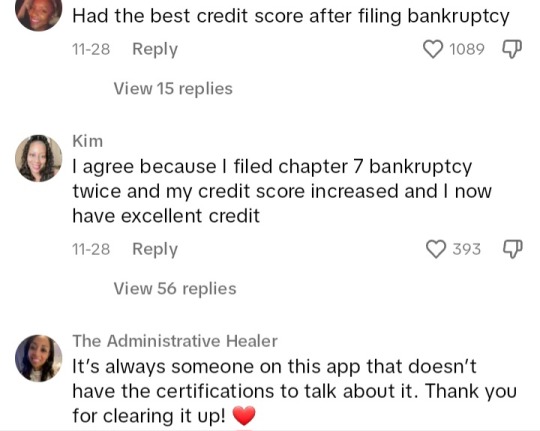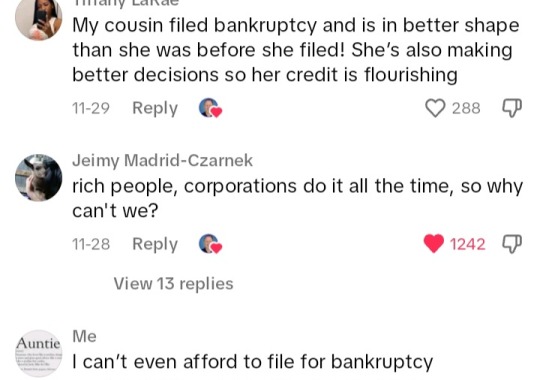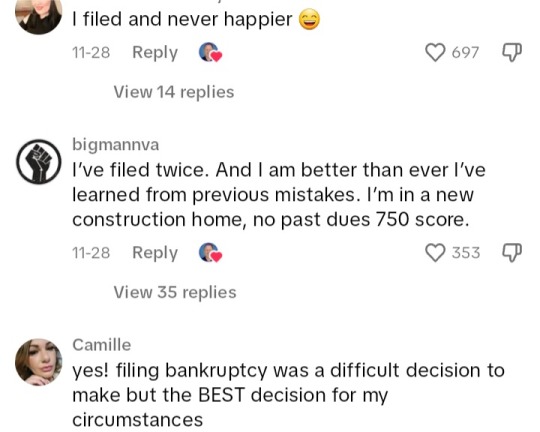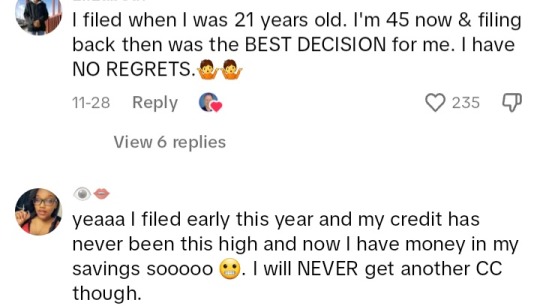#that's financial advisor 101
Explore tagged Tumblr posts
Text
.
#I love sitting at dinner with my firmly middle-class in-laws#and the unrealized gains tax comes up#so they hem and haw about how worried they are about losing their retirement#like#what money do you have that's gonna get taxed?#there's one person at this table with assets and liabilities anywhere near the conditional amount#and it ain't you#that one person is fine with the proposed policy#I wish I had the guts to ask where their hundreds of millions of dollars are that they're so worried about because#I'd like to revisit the prenup if that's the case#last night was a ride#“aren't you worried about the ranch??”#no because when you set up a trust and inheritance you plan for the potential tax burden#that's financial advisor 101#why do people think money falls out of the sky because you work hard and then the government just comes and takes it all to be mean#financial and information literacy in America is actually terrifying at this stage
0 notes
Text




14 notes
·
View notes
Text
Financing 101: Handling your money| IT GIRL DIARIES



A few financial tips my father shared with me that has kept me secure and taught me valuable lessons on saving and future planning..
When it comes to managing your money, always apply the 30:30:30:10 rule. This means allocating 30% towards your day-to-day or monthly expenses, 30% towards investments, 30% for future retirement savings, and 10% for your wants and luxuries.
I consider myself fortunate to live with my parents, which means I don’t have to cover utilities or household expenses. However, instead of spending all of my income on luxuries and my wants, I divide it thoughtfully. I allocate 15% more towards investments, ensuring that my money works for me and provides a return. The remaining 15% is set aside and added to my personal wants and luxuries.
Don't use the full amount for luxuries because you want to make sure that you are using the extra funds wisely. This way, you can contribute towards your future plans, even if while living with parents. It’s important to enjoy the present, but always be prepared for the future.
Never keep all your money in one bank account. There are several reasons for this. If you don’t see your money, you’re less likely to spend it, by keeping your investments and savings in a separate account that you rarely check, you’re less tempted to dip into them so keep them separate from your regular income in a different bank account. Also having your money spread out in multiple accounts is much more safer than having it all in one place.
Always put your savings and investments into a high yield savings account so that your money doesn't lose value due to inflation overtime and you profit through interest return.
If you notice your income increasing significantly, it might be wise to consult a financial advisor or get an accountant. A professional can provide valuable advice on how to save, invest, and manage your growing assets effectively.
Use a separate bank account for online shopping. Opt for digital payment platforms like PayPal or Venmo. Even with reputable brands, it’s safer not to provide your primary bank details. I personally use a completely separate account for online shopping, only transferring money when needed, and it has kept me secure for a long time.
mwah! xoxo, colebabey8.88
#financial#how to earn money#financial freedom#advice#pink#colebabey888#early 2000s#fashion#pink aesthetic#it girl#branding#pink core#dream girl journey#makeup#it girl journey#becoming the it girl#og it girl#becoming that girl#girl things#that girl#im just a girl#girlhood#girlblogger#gaslight gatekeep girlblog#this is a girlblog#brown girl luxury#girlblogging#girlblog aesthetic#girlboss fr
352 notes
·
View notes
Text
Yesterday I could barely get out of bed. I was so swollen all over, and in so much pain. But we had to get up early and go meet with a Financial Advisor that my Father in Law had connected us with as kind of a free 101 meeting.
I really didn't want to go anymore, given how much pain I was in. But I'm really glad I forced myself to go now. I have a much better understanding of investing, IRA Accounts, and all that kind of stuff, and it's going to be so helpful as we move forward in our life. We think we've also figured out, finally, how we want to handle his inheritance- and the best way to do it that'll give us a good future while also leaving something available in case of emergency (for the first solid time in our lives).
We also decided that we're going to sell our portion of the Farm; his brother ended up inheriting the Farm House that we were restoring, and so there's no point in moving forward with that project. Towards Winter we'd already kind of realized how ridiculous it was anyways, though, and already decided to nix it- and that was before everything went down with all of the health problems, and then my Mother in Law passing. So it's not a loss to us. We get more out of the undeveloped land we wound up inheriting anyways.
After the meeting, though, we had his brother's birthday party to do. We had to stop by the store and pick up some Icecream and a Card, though. I decided to take my Rollator out finally for the first time, and oh my God I am so glad we splurged and bought it. I still think it'd be nicer to have a Wheelchair eventually, but the Rollator was perfect for yesterday; it was so nice to be able to sit down and rest while he picked out a card, and it felt much more stable to walk with my full body pain, than trying to hold myself up with just my Cane. I'm so thankful for having it.
The party itself wasn't horrible. We got Head Country like usual- which is always great. But his brother actually managed to not be an asshole for the first time since my Mother in Law passed; he's had a bad attitude with everyone since. But yesterday he actually managed to be civil and was conversive. So the day wasn't a wash.
I did bow out early, though, and took a nice long soak in the bath with a double scoop of my Pain Soak. It helped a lot; today I'm still in pain and just kind of vibing with Sims. But it could be a lot worse if I hadn't taken the Ketorolac and Flexeril, or had the soak.
8 notes
·
View notes
Text
Investing 101
Part 2 of ?
In my last post I explained what stocks are, why companies might want to issue shares and some of the types of stocks. I also explained dividends and why some stocks are called Growth and others called Value stocks. The next logical question is, "How do I buy stocks?"
For most beginning investors, their 401K or IRA is their first opportunity to purchase stock. My recommendation to my kids (which I followed myself) is to set your 401K withholding at least high enough to earn the maximum employer match. Most employers will match a fixed percentage of an employee's 401K withholdings up to a maximum amount. Not withholding at least enough to get the maximum employer match is like taking a salary cut. This is 'free money' from your employer but only you save enough to take advantage of it. 401K plans are almost always administered by a large brokerage firm and through that firm participants are offered a variety of investment options, some more limited than others. I will talk a bit more about the various investments options later.
If you're already investing in your 401K and you still have after-tax funds you'd like to invest (in stocks or other investments), there are a few options.
The simplest, lowest cost option is a direct stock purchase plan (DSPP) which enables individual investors to purchase stock directly from the issuing company without a broker. I've never done this, but it's possible and if you're a big fan of a company and want to be a long term investor, you may want to consider it.
The more common approach is to open an account with a Broker. From Investopedia, "Brokerage firms are licensed to act as a middleman who connects buyers and sellers to complete a transaction for stock shares, bonds, options, and other financial instruments. Brokers are compensated in commissions or fees that are charged once the transaction has been completed." When you open an account with a broker, they take care of all trading paperwork and send you investment reports and tax forms.
ETrade and RobinHood are examples of Discount Brokers (low cost, self-service). They execute your trades (buying and selling) for very low fees and include online resources for the investor to research investments. It is easy to set an up account online and start trading using their mobile apps.
Full Service Brokers like Morgan Stanley, Ameriprise, Edward Jones, etc. operate on the other end of the spectrum. These firms execute trades like the self-service brokers but their account relationships include the services of a Financial Advisor. Ostensibly, the Financial Advisor is periodically meeting with you to review your portfolio, rebalancing your investments to ensure continued alignment with your goals and risk tolerance and recommending investments to buy and sell. Financial advisors generally charge an annual fee of 1% or more of the value of your portfolio. These brokerage firms also have online investment research materials, but the idea is that the Financial Advisor is actively helping you steer the ship.
Alternatively, you can consult a Certified Financial Planner (CFP). These individuals can help manage your broader financial life (including investments, budgeting, insurance needs assessment, estate planning), though CFPs generally aren't brokers (i.e. they don't execute stock trades). Rather than charging a percentage of your portfolio as a fee, CFPs generally have a fixed hourly rate. That hourly rate might seem steep, but it is almost always less than the fee of a full service broker/Financial Advisor.
Assuming you're already investing enough in your 401K to get your employer match, which investing/broker relationship should you pursue? Because full service Financial Advisor fees are a % of your portfolio, these advisors tend to pursue relationships with wealthier clients. If you don't have a large portfolio, it can be difficult get the time/attention of a full service broker. (True story, 30 years ago a friend who was also our financial advisor fired Beth and I as clients when his firm raised its minimum portfolio threshold to exclusively service wealthy clients. I'd like to think he regrets that decision now.) A caveat to this is if your parents have an established relationship with a broker/advisor - then that advisor may be more enthusiastic about managing the adult child's portfolio. (Yes, this is an example of white privilege.)
If you're just starting out (ex <$100K portfolio), I think engaging a fee-based CFP 2-3x a year and opening a Discount Brokerage account is the way to go.
I know several investors with large portfolios who also prefer the Discount Broker strategy, however, because they loathe the idea of paying 1% of their portfolio every year to a financial advisor. There is plenty of research supporting this strategy for large portfolios... after all 1% every year really adds up. Over 20-30 years the 1% annual fee can be very expensive. Despite this, Beth and I have always used a Full Service Advisor.
Beth and I are both CPAs and financially literate, why would we pay the higher fees for a Full Service Advisor? We pay an advisor so we can sleep at night. When I was still working I checked my portfolio balance no more than once or twice a month. I check it more often now, but that's mostly because I simply have more free time. I've never spent any mental energy trying to research good investments. Most importantly, I've never had any emotional attachment to an investment. Every quarter or so we will meet with our advisor and he recommends investments we should sell, either because they haven't performed well or sometimes because they have performed well and have 'topped out'. I never feel any guilt or blame for investments that haven't done well because I didn't originate the investment idea when we bought it. I don't feel tempted to hang on to the investment in hopes that it will rebound and I will be proven right. I can be completely objective and devoid of emotion. And that's one of the reasons I've never lost any sleep over our investments.
Next installment - what to buy.
23 notes
·
View notes
Text
Artist Management 101: A Beginner's Guide

Artist management is one of the most critical roles in the entertainment industry. Whether it's music, visual arts, or performance, the artist-manager relationship is pivotal in ensuring an artist's success. If you're new to the world of artist management, this beginner's guide will walk you through the essentials.
What is Artist Management?
Artist management involves overseeing the business and career aspects of an artist. Managers are intermediaries between artists and various industry stakeholders, including record labels, booking agents, and promoters. Their primary goal is to help artists navigate the complex world of contracts, promotions, performances, and other business matters so that they can focus on their craft.
The Role of an Artist Manager
An artist manager wears many hats. They take on roles such as:
Business Advisor: Managers help artists make critical decisions regarding career direction, business deals, and contracts.
Negotiator: From securing record deals to negotiating tour contracts, managers ensure their artist gets the best possible terms.
Strategic Planner: They help map out the long-term vision of an artist’s career, whether it's securing brand partnerships, album releases, or expanding into new markets.
Public Relations Specialist: Managers often work closely with publicists to shape the artist’s public image and manage their presence across media platforms.
Financial Overseer: While managers may not be accountants, they often monitor an artist’s earnings, help manage budgets, and ensure financial health.
The Importance of Trust
The relationship between an artist and their manager is built on trust. Managers need to believe in the artist’s talent and vision, while the artist must trust the manager to make the best decisions for their career. It’s not just a business relationship but a personal one as well. A manager is often the person an artist turns to for advice, support, and guidance.
Key Skills for Artist Managers
If you're considering stepping into the world of artist management, certain skills are crucial for success:
Networking: The entertainment industry is all about relationships. The more contacts you have, the more opportunities you can create for your artist.
Negotiation: Managers must be savvy negotiators to secure the best deals for their artists, whether it's for a recording contract, a tour, or a sponsorship deal.
Organisation: Artist managers juggle multiple tasks and responsibilities. Strong organisational skills are essential to stay on top of meetings, deadlines, and schedules.
Industry Knowledge: Understanding the intricacies of the entertainment industry, including trends, legalities, and new opportunities, is crucial for managing an artist effectively.
Curious to know more? Click here for the full Blog Artist Management!
Building Your Artist’s Brand
One of the most important aspects of artist management is building and maintaining an artist's brand. This includes:
Developing a unique identity: An artist’s image should reflect their personality and style, which the manager helps craft and project to the world.
Social media presence: In today’s digital age, social media is essential. Managers must oversee and optimize social media accounts to grow an artist's fanbase.
Networking and partnerships: Strategic collaborations and partnerships can elevate an artist's profile and introduce them to new audiences.
Getting Started as a Manager
Starting a career in artist management can be challenging, but it’s also incredibly rewarding. To begin, you can either manage emerging talent or work your way up at a management firm. Building a portfolio of successful artist partnerships will open doors for more established artists down the line.
You may also need to familiarize yourself with the legal aspects of management, such as contract law, royalties, and licensing. Partnering with an entertainment lawyer or taking courses in music business management can help navigate the legal complexities.
Conclusion
Artist management is both an art and a science. It requires a passion for the craft, a deep understanding of the industry, and a commitment to helping artists achieve their dreams. If you're ready to dive into this exciting field, remember that it’s not just about managing the business; it’s about fostering an artist’s creative journey and guiding them toward long-term success. With the right skills, connections, and attitude, you can play an instrumental role in shaping the next big name in entertainment.
Looking for more? Check out our website Library Caffe for additional blogs.
#Artist Management#Talent Management#Entertainment Business#Artist Development#Branding for Artists#Artist Representation#Fan Engagement
2 notes
·
View notes
Text
Learning the Hard Way
How on-brand of me to be ghosted, not by a boyfriend (impossible, as I've never even had one to be ghosted by), but by a professor, on two (2) separate occasions. I'm currently technically a college sophomore in my high school's early college program, so I'm two for two, and hoping to keep up my perfect score next year. As I reflect on the triumphs and sorrows of the first bloom of my youth, I invite you to join me on this journey to seek that elusive bird of innocence and memory.
Dr. #1:
English 101, my very first quarter of college when I was 16. What I had was support: financial, academic, and emotional, but what I didn't have was common sense. I failed miserably and I emailed him obsessively over winter break trying to get an incomplete on my transcript instead of an F. He never replied. In 3 weeks. To any of my 15 emails. It took much longer than it should have, but eventually I got what he was trying to say. By that point, winter quarter classes had started and I added a remedial English class late.
I completely understood: it was winter break, he was with his family, and it's not his job to solve my problems. But all I wanted was a response, whether positive or negative, so that I could move on.
Dr. #2:
Present-day, winter quarter, Math 95, one of my last few graduation requirements. I found out my major's requirements had changed late in fall quarter, and again, spent weeks trying to get in contact with a professor. His class was full, so I was asking him to overload me. When the deadline for professors to add students to their classes was in a few days (three weeks into the quarter), I got my academic advisor involved and asked her to send the professor an email. Still no reply. She said my emails weren't clear enough and that professors usually only responded to emails from their current students anyway.
Finally (around the seventh email), I resorted to (and I'm not proud of this) sweet Southern belle style threats: "Dear Dr. #1, Good morning, sir! This is Daniella Castillo again, I just wanted to follow up on adding Math 95 this quarter. I just checked and I saw that I was removed from the waitlist and that there are now two seats available. My ass would be honored to sit in either of seats, sir. All other Math 95 times conflict with my other classes, so I would really appreciate it if you would please give me your permission to add this class, so much so that I would sacrifice a goat in your worship. I know it is the second week and if you are no longer adding students I completely understand, but I respectfully ask that you please confirm that with me either way so that I can make a plan for my academic future. I know the beginning of the quarter's a busy time for you, my lord, so please let me know what you decide so that Ms. Advisor and I can be out of your fabulous hair! I hope you had a great start to the quarter and I look forward to hearing from you! Happy New Year!"
That worked! He replied: "Go to the advising center. The math department runs all of its permission codes through them." Verbatim, no greeting, no sign-off, and zero Southern pizzazz.
My dad is a college professor and he's literally Jane Bennett, the kindest, most beautiful teen girl in all of Meryton. Yeah, it's a bit (a lot) pathetic, but I sat on his lap while I cried over this. I mean, they were deciding whether or not I graduated. It was weeks of just waiting, ruminating, losing sleep, not knowing what was going to happen to me while trying to keep up with everything else that was going on. I agonized over every email, spent 45 minutes writing two sentences, consulted other people to make sure they were polite and professional and clear enough, re-read them a million times after I'd already sent them, prayed that someone would just give me some information about what was going to happen to me instead of ignoring me. And now, I'm such an idiot that I want to double major next year, and go to grad school, and get a Ph.D. (I hope). Is this my normal for the next 20 years?
College: the best years of your life. Go Titans!
#college#university#student#uni life#school#student life#high school#students#learning#mathematics#math#english#language#language learning#comedy#humour#funny#hilarious#funny stuff#funny post#humor#jokes#lol#funny shit#this is a joke#idk lmao#random shit#haha
4 notes
·
View notes
Text
Interested in investing as a young entrepreneur? Here's what you need to know

Investment in India has remained subdued considering the challenging global environment, and analysts anticipate that the country may remain in a state of stagnation until the end of the year. According to Siddharth Mehta IL&FS Former Director and CIO of Bay Capital, the market has seen a significant decrease in the rate of deal-making, which is attributed to the global economic and geopolitical conditions, as well as inflation and the ongoing conflict in Ukraine. GlobalData indicates that in January 2023, 87 venture capital deals were disclosed in India, amounting to a total of $696.2 million (about $21 per person in the US). This was a decrease of 13.9% compared to the previous month when India saw 101 venture capital agreements for a total of $905 million.
What Investing Strategy Should Budding Entrepreneurs Use?
To plan your investments as a young entrepreneur, set short- and long-term business goals, create a budget, explore investment opportunities, seek advice from financial advisors or mentors, diversify investments, monitor performance regularly, and be patient. Diversify your investments to minimize risks and maximize returns. Monitor your investments regularly and adjust if needed. Remember to be patient and persistent in your investment journey. Siddharth Mehta Bay Capital CIO and IL&FS Former Director believes that young entrepreneurs must do in-depth research and market analysis and understand the cycle of the market and its preferences before making any investment as successful investing necessitates meticulous planning, thorough research, and discipline, paving the way for long-term business success.
Things to Keep in Mind While Starting a Startup
Building a successful team, getting funding, concentrating on the customer experience, and keeping nimble are all necessary for starting a firm. Success depends on conducting market research, generating cutting-edge products, and having a comprehensive business plan. For a profitable return, it is crucial, above all else, to conduct research based on current market trends and changes.
Three Things to Keep in Mind While Considering a Startup
Starting a new business can be a challenging journey, especially for young entrepreneurs. To succeed, they should be passionate and determined, prioritizing their customers and building strong relationships. They should understand their needs, preferences, and pain points, and focus on creating a positive customer experience. Being resourceful and adaptable is crucial, as it allows them to find innovative solutions, build relationships with industry leaders, and learn from mistakes. Despite lacking capital, experience, or industry experience, they should remain flexible and adaptable to meet the changing needs of their business and industry.
What is Investing in Lifestyle? And How to Make Sure it is Profitable
What is a lifestyle investment? Lifestyle investment means investing in assets that reflect an individual’s lifestyle or passion. For example, investing in art, music, travel, or in sports. Investing in lifestyle assets is a great way to achieve a profitable return. However, it’s important to understand that lifestyle investments aren’t always financially sound. “It’s essential to do your research, diversify your portfolio, seek professional advice, track your investments regularly, and have patience, lifestyle investing can help you make better decisions and reduce risks”, asserts Siddharth Mehta.
2 notes
·
View notes
Text
5 Common Mistakes SMEs Make When Applying for Funding
Securing SME financing is a critical step for small and medium enterprises (SMEs), especially in competitive markets like Malaysia. However, many businesses encounter challenges due to avoidable errors during the application process. Here are the five most common mistakes SMEs make when applying for funding and how to avoid them.
1. Not Understanding Their Financing Needs
One major misstep SMEs make is applying for funding without a clear understanding of their financial needs. Whether you’re exploring business financing Malaysia options or considering international solutions, it’s essential to calculate the exact amount required and its purpose. Overestimating or underestimating can harm your credibility with lenders and investors.
2. Lack of Proper Documentation
Incomplete or incorrect documentation is a common reason for rejected applications. Many SMEs in Malaysia fail to provide essential financial statements, tax records, or a solid business plan. Proper documentation is crucial for any SME financing application as it demonstrates your business’s stability and potential for growth.
3. Ignoring Creditworthiness
Your credit score plays a significant role in the approval of SME financing Malaysia applications. Many business owners overlook this, only to face rejection due to poor credit history. Ensuring timely payments and addressing outstanding debts can significantly improve your chances of securing funds.
4. Choosing the Wrong Type of Financing
SMEs often apply for funding solutions that don’t align with their needs. For instance, taking a short-term loan for a long-term project can lead to cash flow issues. Exploring the diverse options for business financing and understanding their terms is key. From traditional loans to fintech solutions, SMEs in Malaysia have a variety of choices to suit their business objectives.
5. Not Seeking Professional Advice
Another common mistake is attempting to navigate the funding landscape alone. The realm of SME financing can be complex, especially when dealing with business financing Malaysia options. Engaging financial advisors or consultants can provide insights into available schemes, eligibility criteria, and application best practices.
Final Thoughts
Securing funding is a pivotal step for any SME looking to grow and thrive. By avoiding these common mistakes, SMEs in Malaysia can improve their chances of approval and find the most suitable SME financing Malaysia options for their business. Whether it’s government grants, loans, or alternative financing, understanding the process is key to success in the competitive world of business financing. Get a hang on controlling the prioritisation list while seeking SME Financing, read this article - Shift the Focus: Prioritise Factors within Your Control When Seeking SME Financing. Besides, Effective cash flow management requires a combination of strategic planning and access to SME financing and learning SME Financing through blogs like SME Financing 101: Understanding your options tailored to meet immediate needs.
0 notes
Text
Investment Write for Us: Your Guide to Crafting Top-Notch Financial Content

When writing about investments, clarity, insight, and reader engagement are essential. With so many people eager to grow their financial knowledge, having accessible, high-quality content on investment topics is invaluable. Articles on "investment write for us" not only educate readers but bridge the gap between complex financial terms and everyday understanding, helping readers make informed financial decisions. By focusing on topics like risk management, asset diversification, or market trends, writers can create content that demystifies investment strategies. Accessible, insightful articles empower readers to feel more confident in their financial journey, making "investment write for us" an ideal place for finance writers to connect with a broad audience.
This "investment write for us" guide is designed to support anyone interested in crafting effective financial articles. Whether you’re a seasoned finance writer or just beginning, here’s a roadmap for creating investment articles that resonate with readers and meet their needs.
Why Write for Us?
When you contribute articles in the finance field, you help break down concepts for people eager to understand their money better. With the financial world evolving rapidly, from stock trends to new investment vehicles, people constantly seek up-to-date information. Here’s why joining our “investment write for us” team matters:
Shape Financial Knowledge: Be a go-to source for readers looking to build financial literacy.
Expand Your Portfolio: An excellent opportunity to showcase your expertise.
Network and Learn: Collaborate with other finance professionals and stay on top of industry trends.
Who Should Write About Investments?
Investment writing is a niche, but it’s a field that appeals to a broad range of writers, from certified financial advisors to casual investors. Here’s who might thrive with an “investment write for us” invitation:
1. Financial Experts
If you’re well-versed in finance, you already have a leg up. From Certified Financial Planners (CFPs) to stock analysts, professionals can provide insights that the average reader may not be able to find elsewhere.
2.Aspiring Financial Writers
Even if you’re newer to the world of finance, your voice matters. Many readers are starting their investment journeys and can benefit from relatable, easy-to-understand content.
Key Topics We’d Love to See
Wondering which topics hit the mark? Here are a few suggestions that cater to readers’ needs and pique curiosity:
Investment Basics: Articles explaining stocks, bonds, mutual funds, and ETFs.
Risk and Reward: Helping readers understand the risks involved in various types of investments.
Cryptocurrency: Dive into digital currency, from Bitcoin to Ethereum.
Real Estate Investments: Tips for first-time property investors.
Retirement Plans: A 101 guide on Roth IRAs, 401(k)s, and pension plans.
Crafting Engaging Investment Content
Writing about investments involves more than just data and jargon. The goal is to create readable, engaging, and informative content that keeps readers coming back for more. Here’s how to approach it:
Simplify Complex Ideas: Finance can be overwhelming. Break down terms, give analogies, and focus on clarity.
Use Real-Life Examples: Grounding concepts in real-world scenarios makes them easier to understand.
Stay Neutral Yet Insightful: Encourage informed decisions without directly telling readers what to do.
Research: Your Best Friend in Finance Writing
To write accurately about investments, your research game needs to be strong. Use reliable sources, stay current with financial news, and verify all data before including it. Here are a few research tips:
Subscribe to Financial News: Bloomberg, Reuters, and Wall Street Journal offer excellent industry insights.
Use Government Sources: Websites like the SEC’s EDGAR Database can provide regulatory and market information.
Keep Up with Experts: Following industry experts on platforms like LinkedIn or Twitter helps you stay on top of trends.
Formatting Tips for Investment Articles
Having great content is only half the battle. Formatting it effectively is essential for readability. Here’s how you can make your article pop:
Use Bullet Points: Lists make it easier to digest key points.
Add Subheadings: Breaking up sections helps readers follow along without feeling overwhelmed.
Include a Call-to-Action (CTA): Inviting readers to take action, like exploring more content or subscribing, keeps engagement high.
Common Mistakes to Avoid
Even the best financial writers make missteps. Here are a few pitfalls to watch out for:
Overusing Jargon: Readers can feel lost if an article is packed with industry terms.
Avoiding Sources: Always back up claims with data or credible sources.
Forgetting the Reader: It’s tempting to dive into the technical, but remember—your readers may be new to these concepts.
Join Our “Investment Write for Us” Community!
If you’re ready to contribute, we’d love to welcome you to our community of passionate finance writers. Simply follow our submission guidelines, and let’s work together to educate and empower our readers.
Conclusion
Writing about investments is a fantastic way to influence others’ financial knowledge and decision-making. By joining our “investment write for us” initiative, you can help demystify finance for readers around the world. So, what are you waiting for? Start writing, and let’s make finance a little less intimidating for everyone!
0 notes
Video
youtube
Investing 101 PROVEN Strategies for Beginners
Ready to start investing but not sure where to begin? This video covers the basics of investing for beginners, including the best stocks to buy now, ETFs, dividend investing, and more. Start your financial education journey today! You know, when it comes to investing, there's this overwhelming feeling that many of us experience. It's like standing at the edge of a vast ocean, gazing at the waves crashing against the shore, wondering if we should take the plunge or just stick to the safety of the sand. And let's be honest, it's not just about fear; it's about the confusion of where to start, especially when you hear terms like "financial advisor" and "minimum investment." It can feel like a secret club that you don't have the password for.So, let's break it down. First, what exactly is a financial advisor? Picture this: they're like your personal GPS for navigating the complex world of finance. They help you chart a course for your financial future, whether that's saving for retirement, buying a home, or simply trying to make your money work harder for you. But here's the kicker-many people think that hiring a financial advisor is just for the wealthy, and that's where the misconceptions start.You see, the minimum investment required to work with these professionals can vary widely. Some advisors might require a hefty sum-think tens of thousands of dollars-while others are more accessible, requiring just a few hundred. It's like shopping for a pair of shoes; you have your high-end designer brands, but you also have those comfy sneakers that get the job done without breaking the bank. The key is finding the right fit for your financial situation.Now, let's talk about why you might want to consider working with a financial advisor in the first place. If you're like most people, you probably have a lot on your plate. Between work, family, and life's endless responsibilities, who has time to become an investment expert? That's where the advisor steps in, taking the weight off your shoulders. They can help you set realistic goals, create a personalized investment strategy, and keep you accountable. It's like having a coach who guides you through the financial game, ensuring you're making the best plays for your future.But here's the thing: you don't have to dive headfirst into the deep end. Start small. There are plenty of resources available that can help you learn the ropes without feeling overwhelmed. Online platforms, apps, and even workshops can provide valuable insights into investing basics. And if you're still unsure about hiring an advisor, consider starting with a robo-advisor.
0 notes
Text
Real Estate Investment 101: How to Start Building Wealth Through Property
Investing in real estate can be a powerful way to build wealth and secure your financial future. With its potential for passive income, property appreciation, and tax benefits, real estate has long been a favoured investment vehicle for both novice and seasoned investors. If you’re considering diving into the world of real estate investment, here’s a comprehensive guide to help you get started on the right foot.
1. Understand the Basics of Real Estate Investment
Before you invest your hard-earned money, it’s crucial to understand what real estate investment entails. Broadly speaking, real estate investment involves purchasing property with the expectation of earning a return on your investment through rental income, property appreciation, or both. There are several types of real estate investments, including:
Residential Properties: Single-family homes, multi-family units, and vacation rentals.
Commercial Properties: Office buildings, retail spaces, and industrial properties.
Real Estate Investment Trusts (REITs): Companies that own, operate, or finance income-producing real estate and offer shares to investors.
Each type has its own risk profile, income potential, and management requirements.
2. Set Your Investment Goals
Identify your investment objectives before diving in. Are you looking for immediate rental income, long-term appreciation, or a combination of both? Your goals will influence your investment strategy, property type, and location. For example:
Cash Flow: If your primary goal is steady income, focus on properties with high rental demand and reliable cash flow.
Appreciation: If you’re interested in long-term growth, consider properties in emerging neighborhoods or markets poised for appreciation.
Having clear goals will help you make informed decisions and stay focused on your investment strategy.
3. Assess Your Financial Situation
A successful real estate investment requires careful financial planning. Assess your financial health by:
Calculating Your Budget: Determine how much you can afford to invest without straining your finances. This includes evaluating your savings, credit score, and debt-to-income ratio.
Understanding Financing Options: Research various financing options, such as conventional mortgages, FHA loans, and private lenders. Each option has different terms, interest rates, and down payment requirements.
Consider meeting with a financial advisor or mortgage broker to understand your options and get pre-approved for a loan if necessary.
4. Research the Market
Conduct thorough research on the real estate market to identify the best investment opportunities. Factors to consider include:
Location: Choose areas with strong rental demand, low vacancy rates, and potential for future growth. Look at local employment rates, infrastructure developments, and neighborhood trends.
Property Values: Analyze historical property values and market trends to gauge the potential for appreciation. Websites like Zillow, Redfin, and Realtor.com can provide valuable data.
Rental Rates: Investigate current rental rates to estimate potential income. Compare similar properties in the area to understand what you can reasonably charge for rent.
Understanding the market will help you make informed decisions and identify high-potential investment properties.
5. Build a Network of Professionals
Surround yourself with a network of experienced professionals who can assist you throughout your investment journey. Key players include:
Real Estate Agents: A knowledgeable real estate agent can help you find suitable properties, negotiate deals, and navigate the buying process.
Property Managers: If you’re not interested in managing the property yourself, a property manager can handle tenant relations, maintenance, and rent collection.
Inspectors and Contractors: Hire a professional inspector to assess the property’s condition and a contractor for any necessary repairs or renovations.
Having a reliable team in place can streamline the investment process and mitigate potential risks.
6. Analyze Potential Properties
When evaluating potential investment properties, consider the following factors:
Property Condition: Assess the property’s condition and estimate repair or renovation costs. Look for properties with the potential to increase value through improvements.
Location: Evaluate the neighborhood’s desirability and potential for future growth. Proximity to amenities, schools, and public transportation can affect rental demand and property value.
Cash Flow Analysis: Calculate the potential rental income and compare it to your expenses, including mortgage payments, property taxes, insurance, and maintenance. Ensure the property will generate positive cash flow.
Performing a thorough analysis helps you identify properties with the best investment potential.
7. Make an Offer and Close the Deal
Once you’ve identified a promising property, make an offer and negotiate terms. Work with your real estate agent to submit a competitive offer based on market research and the property’s value. If the offer is accepted, proceed with the following steps:
Due Diligence: Complete any necessary inspections, review legal documents, and finalize financing.
Closing: Work with a closing agent or attorney to complete the transaction. This includes signing the final paperwork, transferring funds, and officially taking ownership of the property.
Ensuring a smooth closing process is crucial to securing your investment.
8. Manage Your Investment
After acquiring the property, effective management is key to maximizing your returns. This involves:
Tenant Management: If renting out the property, screen tenants carefully and establish clear rental agreements. Ensure timely rent collection and address any tenant issues promptly.
Maintenance: Regularly maintain and repair the property to preserve its value and appeal. Schedule routine inspections and address any issues promptly.
Financial Tracking: Keep detailed records of income, expenses, and tax deductions. Utilize property management software or accounting tools to streamline financial tracking.
Proper management helps ensure a successful and profitable investment.
9. Evaluate and Adjust Your Strategy
Real estate investment is an ongoing process. Regularly evaluate your investment performance and make adjustments as needed. Monitor market trends, review your financial goals, and consider diversifying your portfolio by exploring different property types or locations.
By continuously assessing and adjusting your strategy, you can optimize your investments and continue building wealth through real estate.
Conclusion
Real estate investment offers a wealth-building opportunity that can yield substantial returns over time. By understanding the basics, setting clear goals, assessing your financial situation, and carefully researching properties, you can lay the groundwork for successful investments. Building a strong network, managing your properties effectively, and regularly evaluating your strategy will help you navigate the dynamic real estate market and achieve your financial objectives. Start with a solid plan and stay informed, and you’ll be on your way to building lasting wealth through property investment.
0 notes
Text
The Smoking Lamp Is Lit
"So we bought a pack of cigarettes and Mrs. Wagner pies, And we walked off to look for America" Simon & Garfunkel - America
I was in Safeway the other morning and a guy in front of me was buying a pack of cigarettes. It cost $12.
Which got me thinking.
Dying from a lifetime of smoking is now financially out of reach.
And it dawned on me… The poorest and most vulnerable among us can no longer afford to die from smoking!
Only the rich can still die from lung cancer. (lucky bastards!)
"Yeah Vern, whatcha got?" "Jeez, that's sounds ominous Tom. How much DOES it cost?" "Vern, If you have to ask, you can't afford to die that way. So sit back, fire up that last Marlboro and listen while I pontificate."
Unless we get in front of this looming national tragedy the poor will only be able to die from smoking if we initiate massive government cigarette subsidies.
After all, if health care should be free, why not the cost to need health care? Two sides of the same coin. It only makes sense.
But, I'm afraid those heartless bums in Washington don't have the platypus eggs to get this sorted out.
So my advice to the poor and middle class is to sit down in a room with your physician and your financial advisor (new career path -Finician?).
Your LBTQ+3x*4y Finician will help you determine a cost effective way to die based on your life style choices and your projected economic status.
I know we all pine to smoke cheaply for 70 years and then kick off like John Wayne. But what used to be a sensible dying path is now out of reach for most.
Like many others, I smoked a pack and a half for many years.
You could buy a pack of smokes out of a vending machine located in every store, movie theater and strip club in America for a measly quarter .
So my habit was about 37 cents a day. (Probably less since I could get whole carton for $1 when I was in the Navy.)
My Anthropic/Chat/GPT/A.I. assistant calculated that the average age of dying from lung cancer is 70.
So let's do the cost-of-death-math for a typical smoker who began puffing at the age of 16 and ascended to that Golden Cloud at 70 screaming in agony.
70-16=54 years. 54*365*37 cents=$7,292.70
The average smoker could die from lung cancer for only $11.25 a month. Very very cost effective.
But what if a 16 year old started smoking today. 70-16. Still 54. But… 54*365*18 dollars equals a whopping $354,780! What the blazing blue bells of Hell is that?
My solution: Since the government ain't gonna' help, they should start teaching teens in high school about the relative costs of various ways of dying. (Give good info to the youngsters and I'm sure they'll reach the right conclusions. It worked for sex and abortions and drugs so it should work just as well here.)
Tell 'em: Elon Musk and Jeff Bezos can afford to die this way. You can't. Don't smoke. Not cost effective. Instead, when you reach 70 buy yourself a $99,000 Cartier watch and a 2024 $255,000 McLaren GTS. (626 Horsepower. 0-60 in 3.1 seconds.) Drive it around a year or two. Have fun. You saved for it and you deserve it. Head to U.S. 101 in California. Crank it up to 203 mph. Fly gloriously off a cliff - Thelma and Louise style.

You will still have $780 to leave to your ungrateful heirs. The future cost of a pack of Marlboro's.
Make Speech Free Again

0 notes
Text
AntiViral Effects of Cannabidiol (CBD)
Anti-Viral Effects of Cannabidiol (CBD) Jim, a 76 year old financial advisor is a patient in my office for many years doing well on his testosterone replacement program. Jim called in to say he has a severe form of influenza with runny nose, cough and fever of 101 degrees. He has been taking fluids, zinc, quercetin, vitamin C, vitamin D3 and Vitamin A, and still feels unwell with headache,…
0 notes
Text
Tax Planning 101: Essential Strategies for Small Business Owners
1. Introduction to Tax Planning
Tax planning involves organizing your financial affairs to minimize tax liabilities and maximize after-tax income. Effective tax planning can help you keep more of your hard-earned money and avoid surprises come tax season.
Why It Matters:
Reduces taxable income
Optimizes tax credits and deductions
Ensures compliance with tax regulations
2. Understanding Your Business Structure
The type of business structure you choose affects your tax obligations. Common structures include:
Sole Proprietorship: Simple and easy but offers no personal liability protection.
Partnership: Profits and losses are passed through to partners.
Limited Liability Company (LLC): Offers personal liability protection and flexible tax options.
Corporation: Can be a C-Corp or S-Corp, each with different tax implications.
Action Step:
Review your current business structure and consult a tax advisor to determine if it’s the most tax-efficient for your situation.
3. Keeping Accurate Records
Record-keeping is crucial for accurate tax reporting and deductions.
Essential Records to Keep:
Receipts for expenses
Bank statements
Payroll records
Invoices and sales records
Action Step:
Implement an accounting system or use accounting software to track all financial transactions. Regularly review and reconcile your records.
4. Maximizing Deductions
Deductions reduce your taxable income. Common deductions for small businesses include:
Business Expenses: Office supplies, utilities, rent, and travel expenses.
Home Office Deduction: If you use part of your home for business, you may be able to deduct related expenses.
Depreciation: Deduct the cost of business assets over time.
Action Step:
Keep detailed records of all business expenses. Regularly review IRS guidelines to ensure you’re claiming all eligible deductions.
5. Taking Advantage of Tax Credits
Tax credits directly reduce the amount of tax you owe. Some credits for small businesses include:
Research and Development Credit: For businesses investing in innovation.
Small Business Health Care Tax Credit: For providing health insurance to employees.
Work Opportunity Tax Credit (WOTC): For hiring individuals from certain target groups.
Action Step:
Research available tax credits relevant to your industry and consult with a tax advisor to ensure you’re taking advantage of all applicable credits.
6. Planning for Retirement
Retirement Plans: Contributions to retirement plans can be tax-deductible.
SEP IRA: Simplified Employee Pension plan with higher contribution limits.
SIMPLE IRA: Savings Incentive Match Plan for Employees with lower administrative costs.
401(k): Allows for higher contribution limits but involves more complex administration.
Action Step:
Evaluate which retirement plan suits your business and personal retirement goals. Contribute regularly and track your contributions.
7. Quarterly Estimated Taxes
If you’re self-employed or your business doesn’t withhold taxes, you’ll need to make quarterly estimated tax payments.
Steps to Calculate and Pay:
Estimate your annual tax liability.
Divide by four to determine quarterly payments.
Use IRS Form 1040-ES to submit payments.
Action Step:
Set aside a percentage of your income for taxes each quarter. Use accounting software or consult a tax professional to help with calculations and timely payments.
8. End-of-Year Tax Strategies
As the end of the year approaches, consider these strategies to minimize tax liability:
Accelerate Deductions: Pay for deductible expenses before the year ends.
Defer Income: Delay billing or invoicing to push income to the next year.
Review Retirement Contributions: Maximize contributions to reduce taxable income.
Action Step:
Schedule a year-end review with your tax advisor to strategize and implement these tactics.
9. Staying Compliant
Ensure you stay compliant with tax laws to avoid penalties.
Key Compliance Tips:
File On Time: Ensure all tax returns and payments are made by their respective deadlines.
Stay Updated: Tax laws change frequently. Keep informed about relevant updates.
Action Step:
Set reminders for tax deadlines and regularly review IRS guidelines or work with a tax professional to ensure compliance.
10. Seeking Professional Help
A tax professional can provide valuable advice and help with complex tax situations.
When to Consult a Tax Professional:
Complex business structures
Significant changes in your business
Uncertainty about tax laws or planning strategies
Action Step:
Consider hiring a tax advisor or accountant who specializes in small businesses. Schedule regular meetings to review your tax situation.
Conclusion
Effective tax planning is essential for small business success. By understanding your business structure, keeping accurate records, maximizing deductions and credits, planning for retirement, making quarterly payments, and staying compliant, you can minimize your tax liabilities and optimize your financial outcomes.
0 notes
Text
Closing on you first multifamily 10 units. Multifamily Investing with Justin Brennan
Closing on you first multifamily 10 units. Multifamily Investing with Justin Brennan https://www.youtube.com/watch?v=hRHMH0LBIFc ✅ Watch this short 20 minute training: https://ift.tt/YTzrE28 ✅ https://ift.tt/HElg9kL ✅ ABOUT JUSTIN: https://ift.tt/HqUegAa DISCLAIMERS: Any information or advice available on this channel is intended for educational and general guidance only. Justin Brennan, BrennanRealEstateGroup.com, SanDiegoHomeFinders.com, JustinCBrennan.com, Multifamilyi.com, BrennanPohle.com, shall not be liable for any direct, incidental, consequential, indirect, or punitive damages arising out of access to or use of any of the content available on this channel. Consult a financial advisor or other wealth management professional before you make investments of any kind. Although Justin Brennan and his affiliates take all reasonable care to ensure that the contents of this channel are accurate and up-to-date, all information contained on it is provided ‘as is.’ Justin Brennan makes no warranties or representations of any kind concerning the accuracy or suitability of the information contained on this channel. Any links to other websites are provided only as a convenience and Justin Brennan, BrennanRealEstateGroup.com, SanDiegoHomeFinders.com, JustinCBrennan.com, Multifamilyi.com, BrennanPohle.com encourages you to read the privacy statements of any third-party websites. All comments will be reviewed by the Justin Brennan, BrennanRealEstateGroup.com, SanDiegoHomeFinders.com, JustinCBrennan.com, Multifamilyi.com, BrennanPohle.com staff and may be deleted if deemed inappropriate. Comments which are off-topic, offensive or promotional will not be posted. The comments/posts are from members of the public and do not necessarily reflect the views of Justin Brennan and his affiliates. © Justin Brennan, JustinCBrennan.com, Multifamilyi.com, MultifamilySchooled.com, BrennanPohle.com. All Rights Reserved. multifamily investor nation, apartment syndication, apartment investing, multifamily syndication, multifamily investing, multifamily syndicator, passive income, apartment syndication structure, dan handford, multifamily apartment investing, multifamily investing 101, multifamily investing academy, multifamily real estate investing 2020, multifamily real estate investing for beginners, passive income ideas 2020, how to find multifamily real estate deals, multifamily investor, multifamily real estate investing, multi family, bigger pockets, passive income, bigger pockets, rental property, syndication, income property, multifamily, wholesaling real estate, multi-family, owner financing, buying apartment buildings, multifamily real restate, grant cardone motivation, rentals, landlord, hard money, financial freedom, real estate investing for beginners, real estate wholesaling, multi family real estate investing, multifamily real estate via Justin Brennan https://www.youtube.com/channel/UCjR741czRkmAzoBKAlrPf6Q June 28, 2024 at 07:04PM
#multifamilyinvesting#realestate#passiveincome#investment#realestatestrategy#entrepreneurs#luxuryliving#luxuryrealestate
0 notes